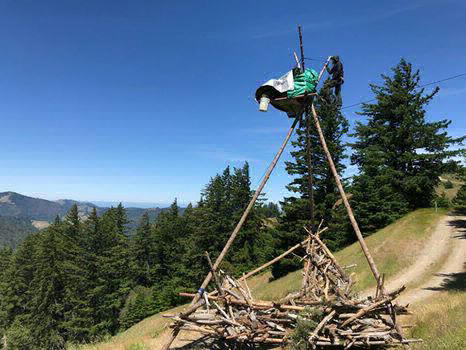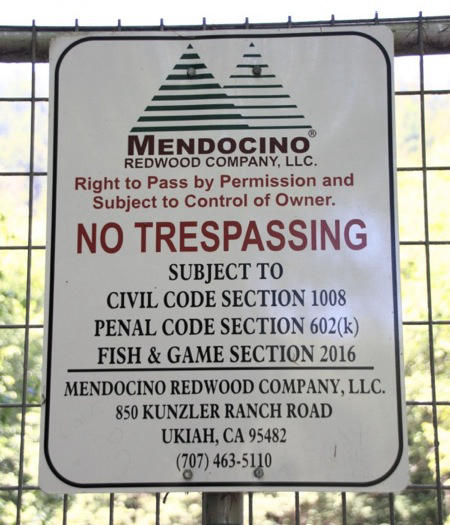Things are hot in California. Air temperatures are triple digits and there are strong winds. One result is at least 17 serious fires burning in California, most notably the Mendocino Complex Fire, the second-largest fire in California history.http://www.latimes.com/local/lanow/la-me-ln-california-wildfires-danger-level-20180806-story.html
There are some other kinds of fires in Trinity, Humboldt and Mendocino Counties, “The Emerald Triangle,” which is also the epicenter of thousands of illegal trespass marijuana grows, as well as the site of the 1990 battle between eco-activists and loggers named “Redwood Summer.” Organized by Earth First!, Redwood Summer involved 1,500 activists dressed as owls and singing protest songs. They chained themselves to heavy equipment, blocked logging roads, climbed trees, and suspended themselves by wires above highways to protest logging of old-growth redwoods. Things got violent at times. http://articles.latimes.com/1990-09-02/news/mn-2050_1_north-coast
The issue behind Redwood Summer was that 95% of the original 2 million acres of virgin redwoods had been cut down. After Redwood Summer reached an uneasy truce, some good things happened. Virtually all remaining redwoods are now protected to a significant degree and restoration efforts are planned or underway for 95% of the redwood forest that was logged.
Following Redwood Summer and the bankruptcy of Pacific Lumber in 2006, the subsequent acquisition of the lands by Humboldt Redwood Company seemed like the old-growth forest of the headwaters of the Mattole River were saved. HRC promised not to log old-growth forest and won community support. But, in 2014 HRC re-conceptualized their old-growth forest policy and began felling old-growth trees. This immediately prompted protests.
The company attempted to resume logging in May of 2017, sending in crews to “restore the balance” of species on previously logged lands by using herbicides to remove madrones, tanoaks, canyon oaks, and others in nearly 200 acres of mixed species forest -- but no Douglas firs. In June of 2017, forest activists blocked a road under the banner “Save the Mattole’s Ancient Forest,” stopping the herbicide operation, and no timber was extracted.
The current battle in the Emerald Triangle between environmentalists and the Mendocino Redwood Company centers at Rainbow Ridge, an 18,000 acre forested tract on the headwaters of the Mattole River where there are about 1,100 acres of old-growth Douglas fir and associated hardwoods, but no redwoods.
As before, the conflict began with lawsuits, but when California’s logging and fire prevention agencies didn’t object to the logging, protestors began sneaking onto Rainbow Ridge to block logging. Two new protest strategies are building a tripod structure over the Monument Gate Road that enters Rainbow Ridge to prevent lumber trucks and heavy equipment from entering. And, to make it more difficult for them to be extracted, some protestors are linking themselves together using the “Sleeping Dragon” method of wrapping their arms and hands together with chains and other materials. https://medium.com/homeland-security/poking-the-sleeping-dragon-fed7fffe4fc5

There are two species of Douglas fir – green, coastal species found from BC to northern CA; and blue, found in the Rocky Mountains from Canada to the Mexican border. The total acreage of forests in the Douglas-fir region has declined from approximately 15 million acres at the time of settlement to 5 million acres at present, but it’s not an endangered species. Most of original old-growth Douglas fir forests have been logged.
Mendocino Redwood Company says that it will cut only 14% of the old-growth fir trees on Rainbow Ridge, and they promise to remove some hardwoods to allow for reforesting with Douglas firs.
Nonetheless, protestors want all logging stopped and the property transferred to the U California Natural Reserve system. https://alumni.berkeley.edu/california-magazine/just-in/2018-02-13/california-timber-battles-shift-new-grounds
. Rainbow Ridge currently is a battleground. If protestors won’t leave, they’re arrested. On July 22nd, three protestors were arrested by security guards and county sheriff deputies came to take away the prisoners. Some contest the arrests, but entering an area with “No Trespassing” signs is a crime. In some states trespassing is a misdemeanor. In others it can be a felony.

In support of law enforcement officers, how do you know that a trespasser isn’t a terrorist? Terrorist websites encourage people to set fires as a weapon.
There have been a number of articles featuring the protestors’ views. http://www.cbs8.com/story/38710999/two-arrested-at-civil-disobedience-protest-on-rainbow-ridge Some balance is needed. An April 2018 article offers corrections about what Mendocino Redwood Company says they will do. https://www.hrcllc.com/sites/default/files/inlinefiles/Warriors%20of%20Rainbow%20Ridge.pdf
In a conflict like this, both sides need to understand the law, tell the truth, and understand the opposition.
A Fact Check on protestors claims finds:
Some eco-activists claim that several endangered species will be harmed by logging Rainbow Ridge, specifically: Pacific fishers, coho salmon, northern goshawk, golden eagle, northern spotted owls, and a fungus, Agarikon. https://kymkemp.com/2018/07/26/man-protesting-logging-rainbow-ridge-describes-ordeal/
Pacific Fisher -- Fishers are common weasel-like animals that live in the forests of Canada, New England, Midwest, and Rockies. Only one subspecies found along the Pacific Coast, the “Pacific Fisher,” is listed as “threatened.”https://www.fws.gov/cno/es/fisher/
Coho Salmon – Coho salmon were once common in the Mattole River. Today, they’re only a few left. NOAA lists one subspecies of coho salmon as “endangered” and three other subspecies “threatened.” https://www.fisheries.noaa.gov/species/coho-salmon-protected Farther north in Canada and Alaska coho salmon are common.
Some assert that the decline in Mattole salmon is primarily due to road building, logging and farming leading to streambed damage. http://articles.latimes.com/1985-08-16/sports/sp-3103_1_mattole-river Actually, there’s already a Mattole River Restoration Program underway involving the Mattole Restoration Council, Mattole Salmon Group, and Sanctuary Forest, in collaboration with the watershed landowners, multiple private and agency funders. https://en.wikipedia.org/wiki/Mattole_River
Northern goshawk -- Northern goshawks have a world-wide circumpolar distribution. They are listed in Appendix II of CITES as “Least Concern” (Population stable).
Golden Eagle -- Golden eagles also have a global distribution. Their conservation status is listed as: “Least Concern” (Population stable)
Northern Spotted Owl -- The USFWS lists the northern spotted owl as “Threatened.” https://www.fws.gov/oregonfwo/articles.cfm?id=149489595 When spotted owls can’t find old-growth forest they become more susceptible to starvation and predation. However, competition from larger barred owls migrating westward is a more important cause of the decline in spotted owls.
Agarikon (Laricifomes officinalis) – is a wood-decay fungus found in Europe, Asia, Africa and North America that causes brown heart rot on conifers. It’s commonly known as quinine conk because of its bitter taste. However, it doesn’t contain quinine, and it has no anti-malarial properties. Extracts do have antiviral activity against some viruses and they prefer Douglas firs.
* * * * * * *
People have a right to voice their opinions. Rainbow Ridge is a beautiful area, but not telling the truth undermines all conservation work.
Recent studies http://journeytoforever.org/bflpics/EnvironmentInc.pdf have found that support for environmental groups is declining because many appear to be dependent on crises, real or not.
Instead of lawsuits and protests, why not work with business and government agencies to solve problems like the Mattole River Restoration Program? Green alliances are definitively an alternative. http://www.inquiriesjournal.com/articles/665/green-alliances-collaboration-between-businesses-and-environmental-advocacy-organizations
Redwood Summer got violent at times. Hopefully, this time people can work on non-violence and problem-solving.
Actually, Mother Nature is also letting people know what it thinks. The other day a guard dozed off sitting in his truck. When he woke up, he got out and met a mountain lion 10 yards away. They eyed each other for a minute or two, and then the lion walked away. That was the second time a mountain lion has been spotted on Rainbow Ridge.
-- James A Swan, PhD